Study on Profitability of Combining Wood and CFRP into Composite Based on Mechanical Performance of Bent Beams
Abstract
:1. Introduction
2. Materials and Methods
2.1. Models’ Assumptions
2.2. Analysed Beams’ Cross-Sections
2.3. Materials’ Prices
3. Results and Discussion
3.1. Costs of the Constituent Materials
3.2. IncreasesinStiffness and Load-Bearing Capacity
3.3. Study on Cost in Relation to Mechanical Properties of Reinforced and Unreinforced Beams
4. Conclusions
Author Contributions
Funding
Acknowledgments
Conflicts of Interest
References
- Schober, K.-U.; Harte, A.M.; Kliger, R.; Jockwer, R.; Xu, Q.; Chen, J.-F. FRP reinforcement of timber structures. Constr. Build. Mater. 2015, 97, 106–118. [Google Scholar] [CrossRef] [Green Version]
- Franke, S.; Franke, B.; Harte, A.M. Failure modes and reinforcement techniques for timber beams—State of the art. Constr. Build. Mater. 2015, 97, 2–13. [Google Scholar] [CrossRef]
- Raftery, G.M.; Whelan, C. Low-grade glued laminated timber beams reinforced using improved arrangements of bonded-in GFRP rods. Constr. Build. Mater. 2014, 52, 209–220. [Google Scholar] [CrossRef]
- Bergner, K.; Tosch, M.; Zauer, M.; Spickenheuer, A.; Wagenführ, A.; Heinrich, G. Process development for the manufacture of fiber reinforced wood composites (FRWC). Constr. Build. Mater. 2018, 180, 275–284. [Google Scholar] [CrossRef]
- Yang, H.; Ju, D.; Liu, W.; Lu, W. Prestressed glulam beams reinforced with CFRP bars. Constr. Build. Mater. 2016, 109, 73–83. [Google Scholar] [CrossRef] [Green Version]
- Andor, K.; Lengyel, A.; Polgár, R.; Fodor, T.; Karácsonyi, Z. Experimental and statistical analysis of spruce timber beams reinforced with CFRP fabric. Constr. Build. Mater. 2015, 99, 200–207. [Google Scholar] [CrossRef]
- de la Rosa García, P.; Cobo Escamilla, A.; González García, M.N. Analysis of the flexural stiffness of timber beams reinforced with carbon and basalt composite materials. Compos. Part B Eng. 2016, 86, 152–159. [Google Scholar] [CrossRef]
- Rescalvo, F.; Valverde-Palacios, I.; Suarez, E.; Gallego, A. Experimental Comparison of Different Carbon Fiber Composites in Reinforcement Layouts for Wooden Beams of Historical Buildings. Materials 2017, 10, 1113. [Google Scholar] [CrossRef] [Green Version]
- Nadir, Y.; Nagarajan, P.; Ameen, M.; Arif, M. Flexural stiffness and strength enhancement of horizontally glued laminated wood beams with GFRP and CFRP composite sheets. Constr. Build. Mater. 2016, 112, 547–555. [Google Scholar] [CrossRef]
- Vahedian, A.; Shrestha, R.; Crews, K. Experimental and analytical investigation on CFRP strengthened glulam laminated timber beams: Full-scale experiments. Compos. Part B Eng. 2019, 164, 377–389. [Google Scholar] [CrossRef]
- Brunetti, M.; Christovasilis, I.P.; Micheloni, M.; Nocetti, M.; Pizzo, B. Production feasibility and performance of carbon fibre reinforced glulam beams manufactured with polyurethane adhesive. Compos. Part B Eng. 2019, 156, 212–219. [Google Scholar] [CrossRef]
- Subhani, M.; Globa, A.; Al-Ameri, R.; Moloney, J. Flexural strengthening of LVL beam using CFRP. Constr. Build. Mater. 2017, 150, 480–489. [Google Scholar] [CrossRef]
- Zhang, C.; Chun, Q.; Wang, H.; Lin, Y.; Shi, J. Experimental study on the flexural behaviour of timber beams strengthened with high ductility and low cost hybrid fibre sheets. Constr. Build. Mater. 2022, 322, 126514. [Google Scholar] [CrossRef]
- Halicka, A.; Ślósarz, S. Strengthening of timber beams with pretensioned CFRP strips. Structures 2021, 34, 2912–2921. [Google Scholar] [CrossRef]
- Halicka, A.; Sl, S. Analysis of behavior and failure modes of timber beams prestressed with CFRP strips. Compos. Struct. 2022, 301, 116171. [Google Scholar] [CrossRef]
- Jankowski, L.J.; Jasieńko, J.; Nowak, T.P. Experimental assessment of CFRP reinforced wooden beams by 4-point bending tests and photoelastic coating technique. Mater. Struct. 2010, 43, 141–150. [Google Scholar] [CrossRef]
- Nowak, T.P.; Jasieńko, J.; Czepiżak, D. Experimental tests and numerical analysis of historic bent timber elements reinforced with CFRP strips. Constr. Build. Mater. 2013, 40, 197–206. [Google Scholar] [CrossRef]
- Morales-Conde, M.J.; Rodríguez-Liñán, C.; Rubio-de Hita, P. Bending and shear reinforcements for timber beams using GFRP plates. Constr. Build. Mater. 2015, 96, 461–472. [Google Scholar] [CrossRef]
- Raftery, G.M.; Harte, A.M. Low-grade glued laminated timber reinforced with FRP plate. Compos. Part B Eng. 2011, 42, 724–735. [Google Scholar] [CrossRef]
- Raftery, G.M.; Rodd, P.D. FRP reinforcement of low-grade glulam timber bonded with wood adhesive. Constr. Build. Mater. 2015, 91, 116–125. [Google Scholar] [CrossRef]
- Glišović, I.; Stevanović, B.; Todorović, M. Flexural reinforcement of glulam beams with CFRP plates. Mater. Struct. 2016, 49, 2841–2855. [Google Scholar] [CrossRef]
- Yang, H.; Liu, W.; Lu, W.; Zhu, S.; Geng, Q. Flexural behavior of FRP and steel reinforced glulam beams: Experimental and theoretical evaluation. Constr. Build. Mater. 2016, 106, 550–563. [Google Scholar] [CrossRef]
- He, M.; Wang, Y.; Li, Z.; Zhou, L.; Tong, Y.; Sun, X. An Experimental and Analytical Study on the Bending Performance of CFRP-Reinforced Glulam Beams. Front. Mater. 2022, 8, 607. [Google Scholar] [CrossRef]
- Kawecki, B. Dobór Parametrów Modeli Obliczeniowych Pełnych Dźwigarów z Kompozytów Drewno-Polimerowych Zbrojonych Włóknami (Selection of the Parameters for Numerical Models of Full Girders Made of Wood-Polymer Composites Reinforced with Fibres); Wydawnictwo Politechniki Lubelskiej: Lublin, Poland, 2021. [Google Scholar]
- Kawecki, B.; Podgórski, J. The Effect of Glue Cohesive Stiffness on the Elastic Performance of Bent Wood–CFRP Beams. Materials 2020, 13, 5075. [Google Scholar] [CrossRef]
- Kawecki, B. Guidelines for FEM modelling of wood-CFRP beams using ABAQUS. Arch. Civ. Eng. 2021, 67, 175–191. [Google Scholar]
- Kawecki, B.; Podgórski, J. 3D ABAQUS simulation of bent softwood elements. Arch. Civ. Eng. 2020, 66, 323–337. [Google Scholar]
- PN-EN 14080:2013; Glued Laminated Timber and Glued Solid Timber—Requirements. Polski Komitet Normalizacyjny: Warsaw, Poland, 2013.
- S&P C-LAMINATE—Technical Information. Available online: https://www.sp-reinforcement.pl/sites/default/files/field_product_col_doc_file/c-laminates_polska_ver012019-low.pdf (accessed on 1 January 2019).



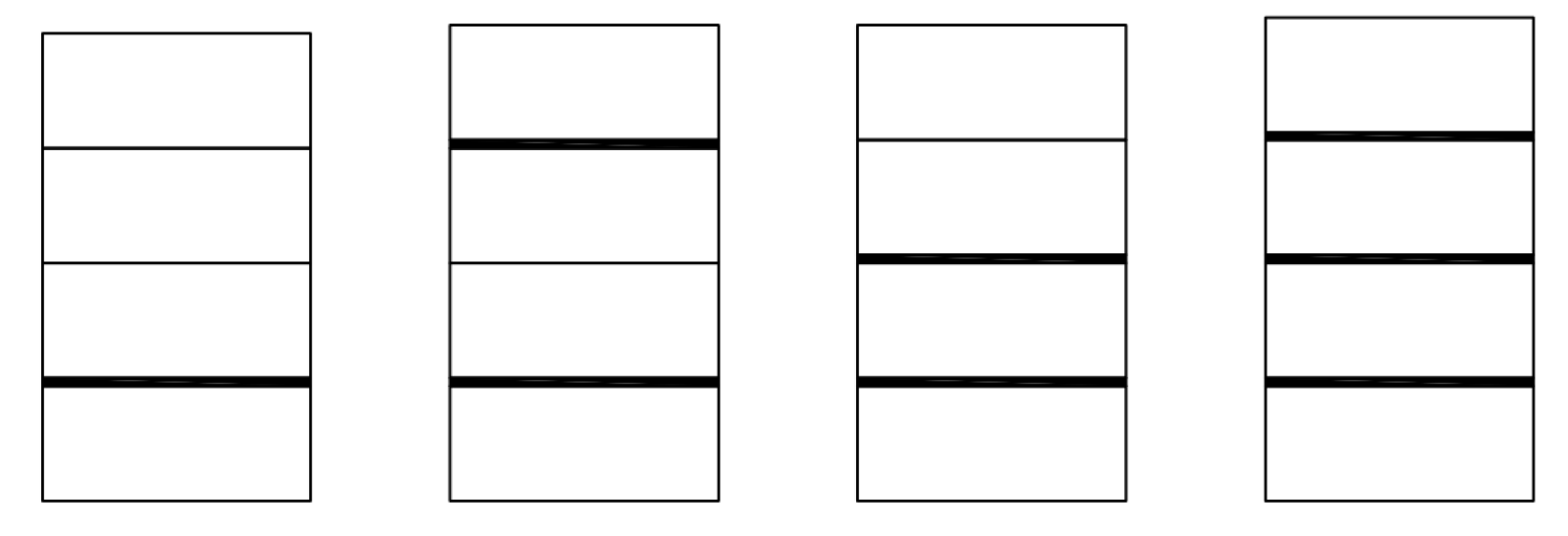
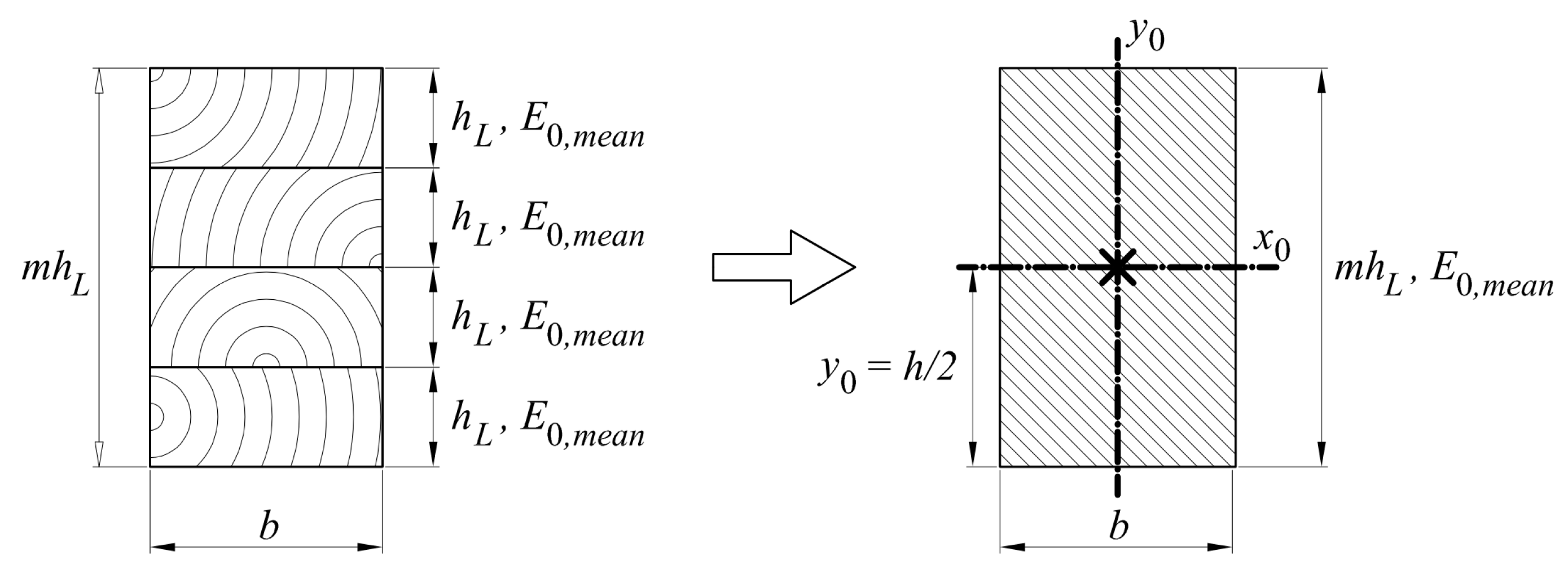

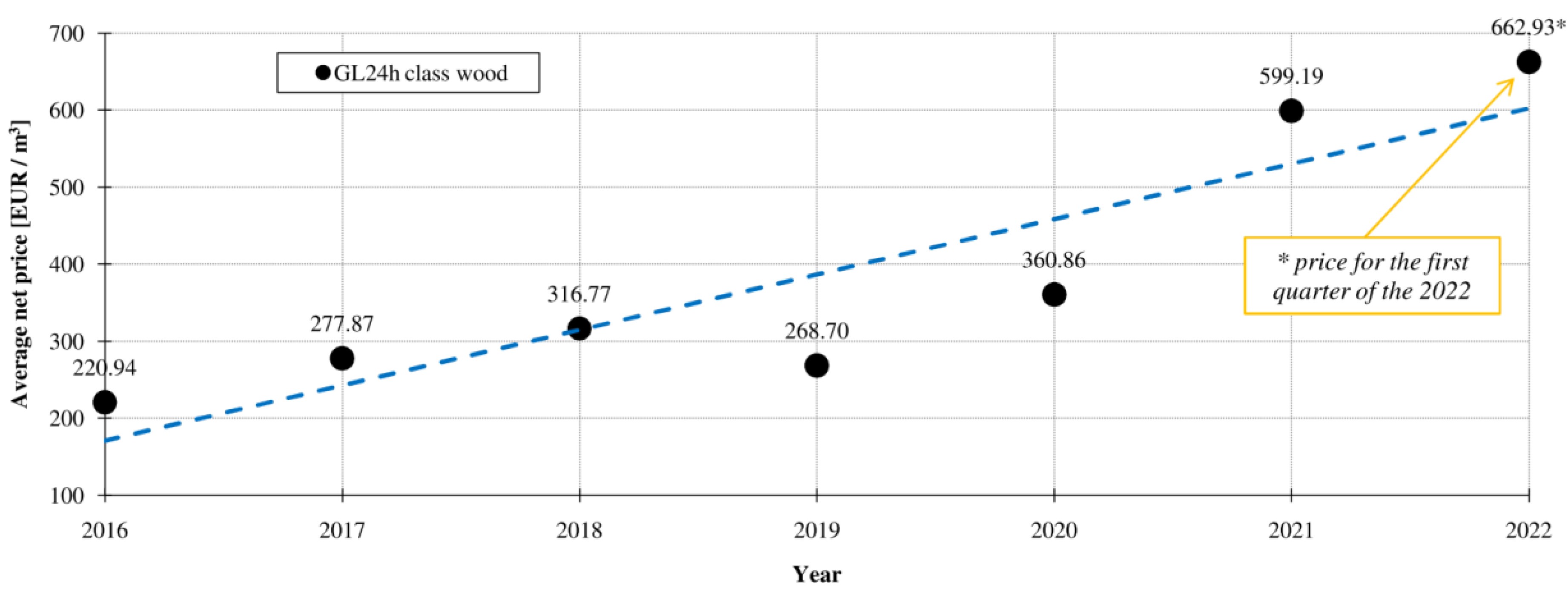
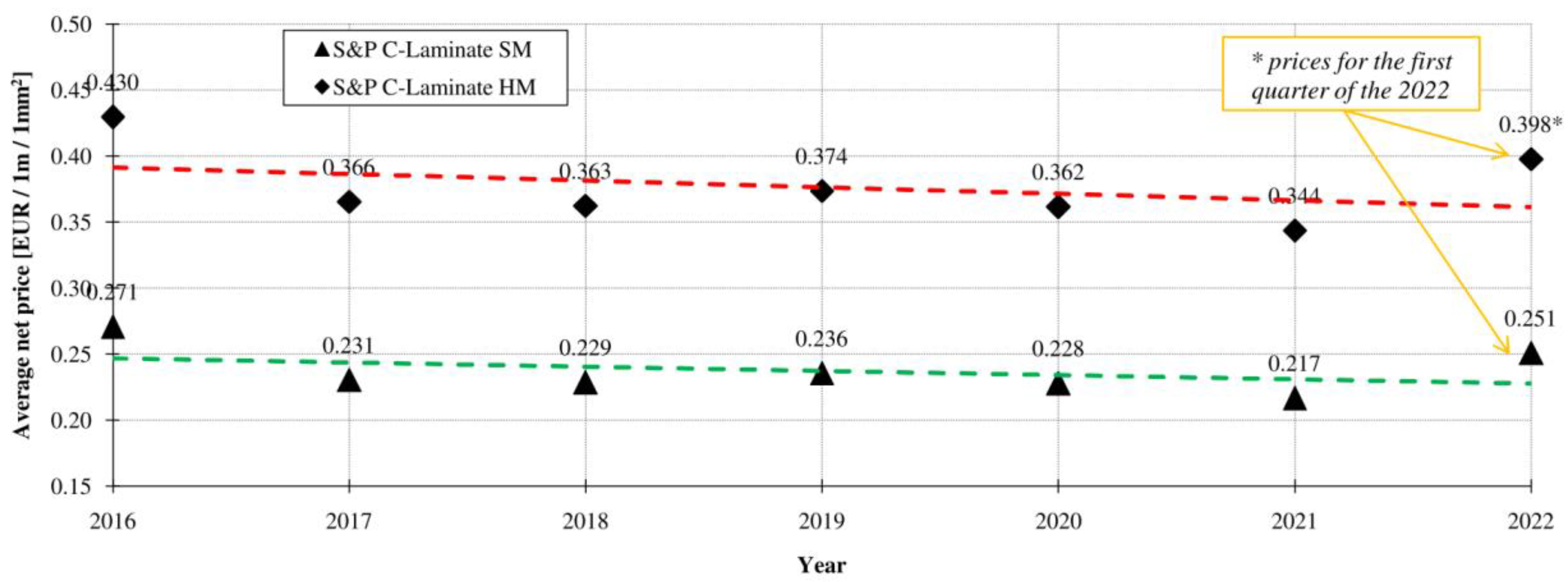
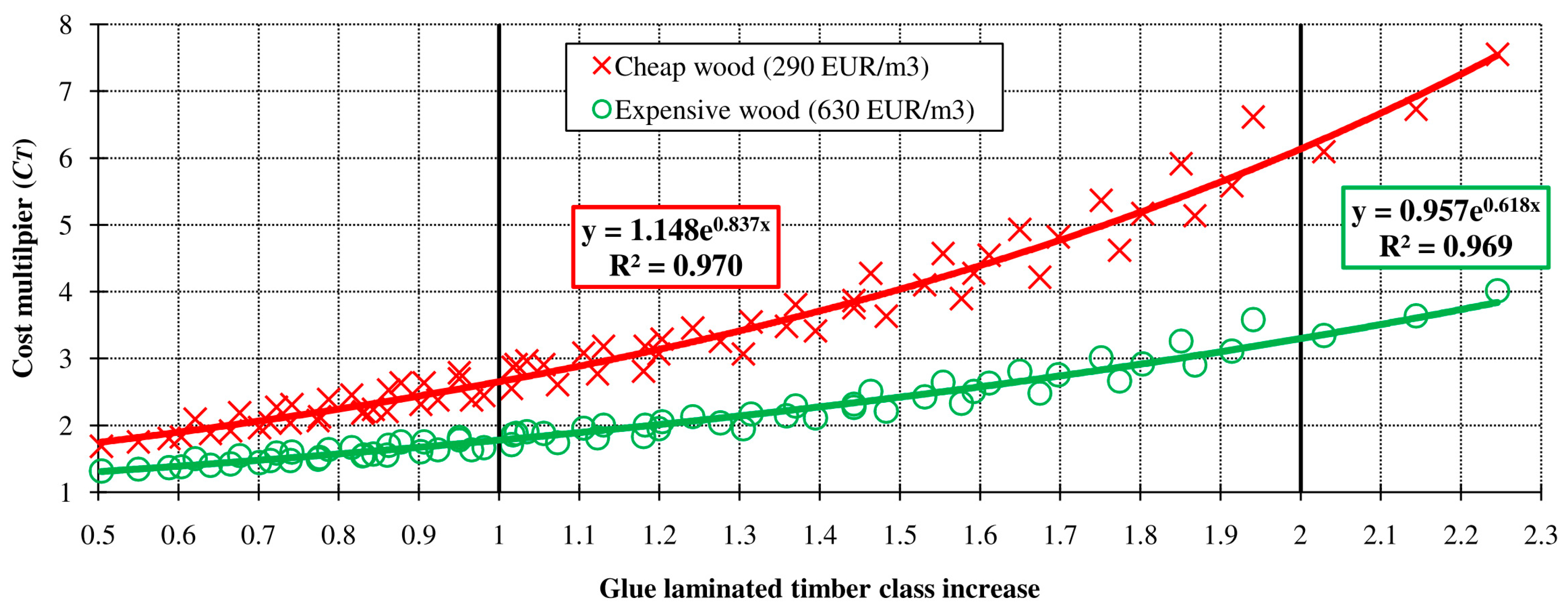
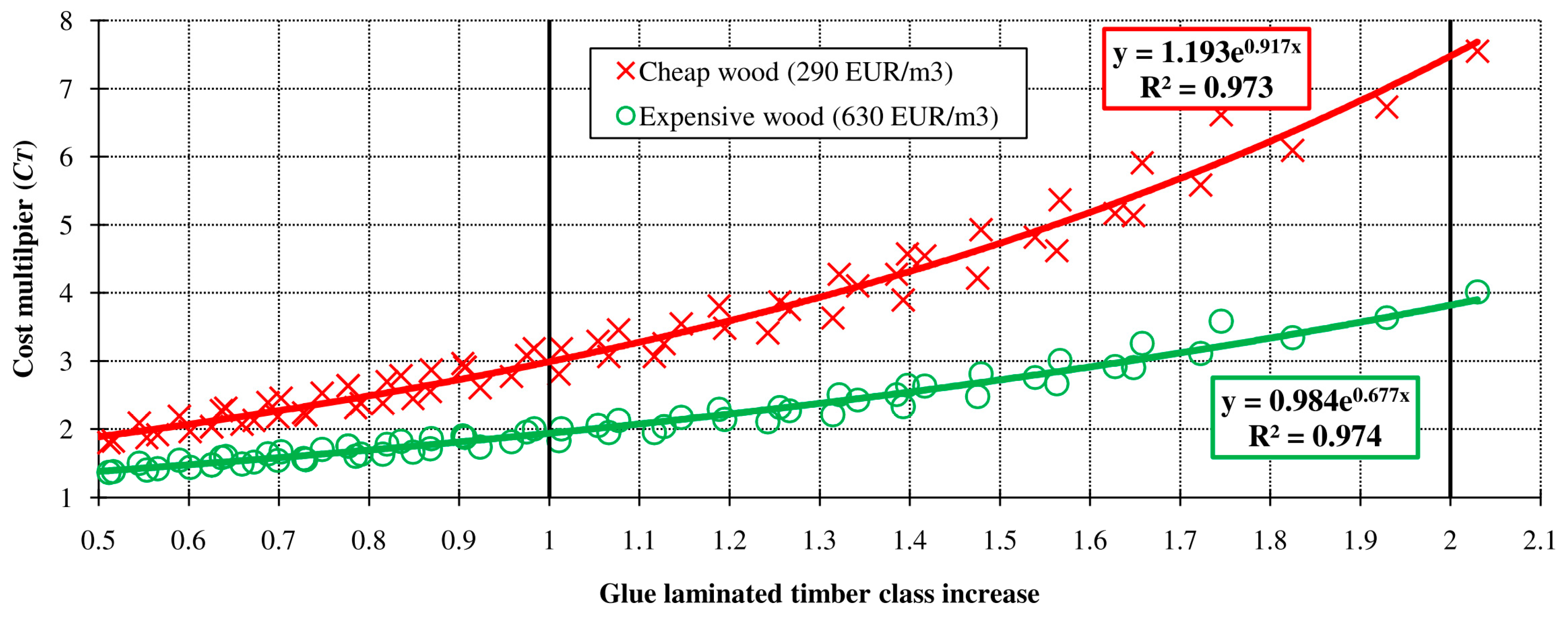

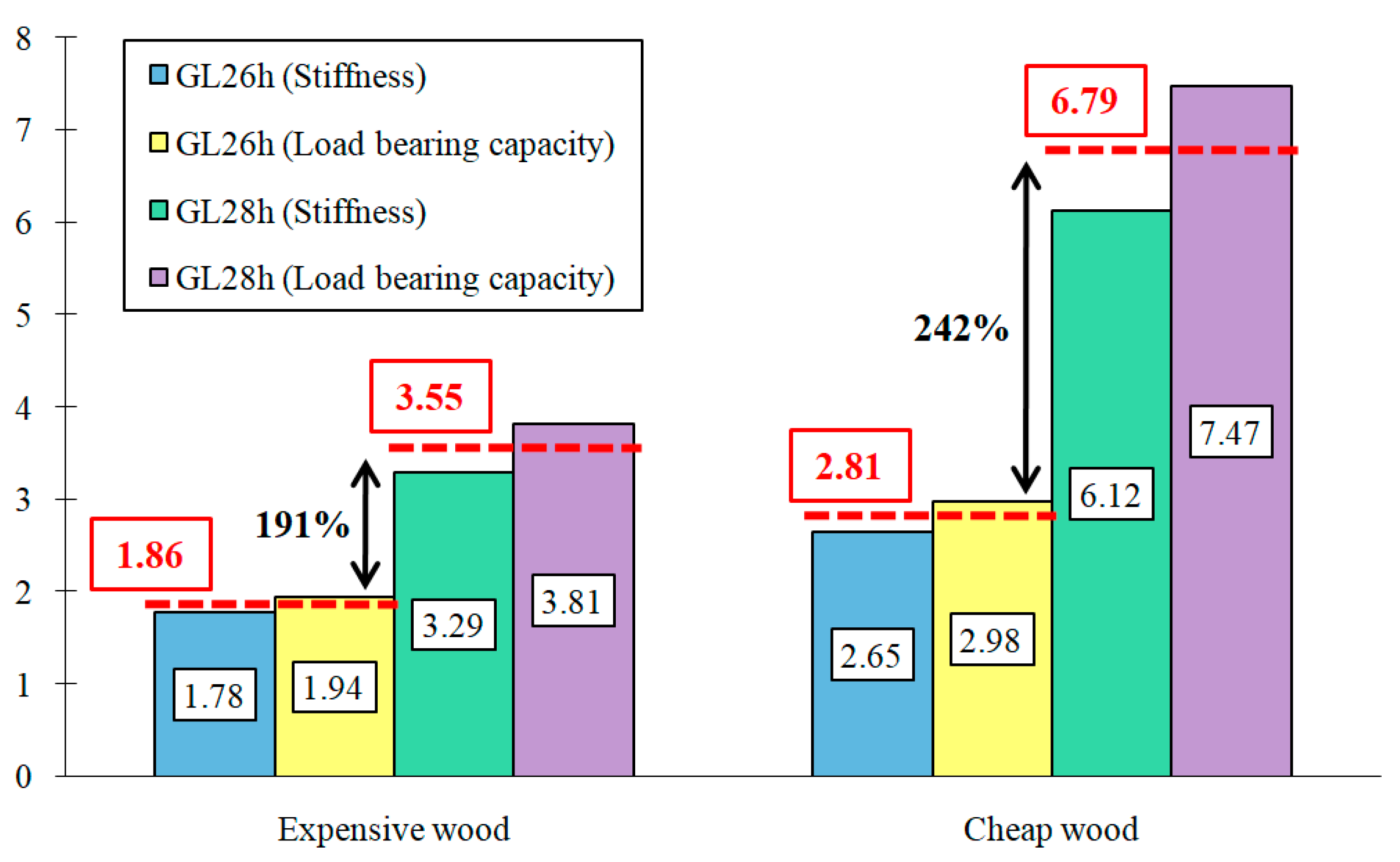
| L/h | 21.43 | 18.75 | 16.67 | 15.00 | 13.64 | 12.50 |
| Length (m) | Height (mm) (Number of Wooden Lamellas) | |||||
| 6 | 280 (7) | 320 (8) | 360 (9) | 400 (10) | 440 (11) | 480 (12) |
| 12 | 650 (14) | 640 (16) | 720 (18) | 800 (20) | 880 (22) | 960 (24) |
| 18 | 840 (21) | 960 (24) | 1080 (27) | 1200 (30) | 1320 (33) | 1440 (36) |
| L/h | 21.43 | 18.75 | 16.67 | 15.00 | 13.64 | 12.50 | ||
| Length L(m) | Width (mm) | CFRP Tape Cross-Sectional Area t = 1.2 mm/t = 1.4 mm (mm2) | BSH Volume (m3) | |||||
| 6 | 100 | 120/140 | 0.168 | 0.192 | 0.216 | 0.240 | 0.264 | 0.288 |
| 120 | 144/168 | 0.202 | 0.230 | 0.259 | 0.288 | 0.317 | 0.346 | |
| 150 | 180/210 | 0.252 | 0.288 | 0.324 | 0.360 | 0.396 | 0.432 | |
| 12 | 100 | 120/140 | 0.672 | 0.768 | 0.864 | 0.960 | 1.056 | 1.152 |
| 120 | 144/168 | 0.806 | 0.922 | 1.037 | 1.152 | 1.267 | 1.382 | |
| 150 | 180/210 | 1.008 | 1.152 | 1.296 | 1.440 | 1.584 | 1.728 | |
| 18 | 100 | 120/140 | 1.512 | 1.728 | 1.944 | 2.160 | 2.376 | 2.592 |
| 120 | 144/168 | 1.814 | 2.074 | 2.333 | 2.592 | 2.851 | 3.110 | |
| 150 | 180/210 | 2.268 | 2.592 | 2.916 | 3.240 | 3.564 | 3.888 | |
| Length (m) | Width (mm) | S&P C-Laminate/1.2 mm (EUR) | S&P C-Laminate/1.4 mm (EUR) | ||
|---|---|---|---|---|---|
| 6 | 100 | 173 | 202 | 274 | 319 |
| 120 | 207 | 242 | 328 | 383 | |
| 150 | 259 | 302 | 410 | 479 | |
| 12 | 100 | 346 | 403 | 547 | 638 |
| 120 | 415 | 484 | 657 | 766 | |
| 150 | 518 | 605 | 821 | 958 | |
| 18 | 100 | 518 | 605 | 821 | 958 |
| 120 | 622 | 726 | 985 | 1149 | |
| 150 | 778 | 907 | 1231 | 1436 | |
| L/h | 21.43 | 18.75 | 16.67 | 15.00 | 13.64 | ||
| Length (m) | Width (mm) | Cost of “Cheap” BSH (EUR) | |||||
| 6 | 100 | 49 | 56 | 63 | 70 | 77 | 84 |
| 120 | 59 | 67 | 75 | 84 | 92 | 100 | |
| 150 | 73 | 84 | 94 | 104 | 115 | 125 | |
| 12 | 100 | 195 | 223 | 251 | 278 | 306 | 334 |
| 120 | 234 | 267 | 301 | 334 | 367 | 401 | |
| 150 | 292 | 334 | 376 | 418 | 459 | 501 | |
| 18 | 100 | 438 | 501 | 564 | 626 | 689 | 752 |
| 120 | 526 | 601 | 677 | 752 | 827 | 902 | |
| 150 | 658 | 752 | 846 | 940 | 1034 | 1128 | |
| L/h | 21.43 | 18.75 | 16.67 | 15.00 | 13.64 | ||
| Length (m) | Width (mm) | Cost of “Expensive” BSH (EUR) | |||||
| 6 | 100 | 106 | 121 | 136 | 151 | 166 | 181 |
| 120 | 127 | 145 | 163 | 181 | 200 | 218 | |
| 150 | 159 | 181 | 204 | 227 | 249 | 272 | |
| 12 | 100 | 423 | 484 | 544 | 605 | 665 | 726 |
| 120 | 508 | 581 | 653 | 726 | 798 | 871 | |
| 150 | 635 | 726 | 816 | 907 | 998 | 1089 | |
| 18 | 100 | 953 | 1089 | 1225 | 1361 | 1497 | 1633 |
| 120 | 1143 | 1307 | 1470 | 1633 | 1796 | 1959 | |
| 150 | 1429 | 1633 | 1837 | 2041 | 2245 | 2449 | |
| L/h | 21.43 | 18.75 | 16.67 | 15.00 | 13.64 | ||
| Length (m) | Stiffness /Load-Bearing Capacity | Increases of Stiffness and Load-Bearing Capacity (%) | |||||
| 6 | Kincr | 8.41 | 7.99 | 7.53 | 7.09 | 6.66 | 6.26 |
| Pincr | 11.80 | 11.18 | 10.55 | 9.95 | 9.39 | 8.88 | |
| 12 | Kincr | 5.86 | 5.30 | 4.82 | 4.40 | 4.05 | 3.73 |
| Pincr | 7.98 | 7.23 | 6.59 | 6.06 | 5.60 | 5.21 | |
| 18 | Kincr | 4.33 | 3.86 | 3.47 | 3.15 | 2.87 | 2.63 |
| Pincr | 5.82 | 5.21 | 4.71 | 4.30 | 3.95 | 3.65 | |
| L/h | 21.43 | 18.75 | 16.67 | 15.00 | 13.64 | ||
| Length (m) | Stiffness /Load-Bearing Capacity | Increases of Stiffness and Load-Bearing Capacity (%) | |||||
| 6 | Kincr | 9.75 | 9.26 | 8.74 | 8.23 | 7.74 | 7.28 |
| Pincr | 13.73 | 13.02 | 12.29 | 11.60 | 10.95 | 10.35 | |
| 12 | Kincr | 6.81 | 6.16 | 5.60 | 5.12 | 4.71 | 4.34 |
| Pincr | 9.30 | 8.42 | 7.69 | 7.07 | 6.54 | 6.08 | |
| 18 | Kincr | 5.04 | 4.49 | 4.04 | 3.66 | 3.34 | 3.07 |
| Pincr | 6.79 | 6.08 | 5.49 | 5.01 | 4.61 | 4.26 | |
| L/h | 21.43 | 18.75 | 16.67 | 15.00 | 13.64 | ||
| Length (m) | Stiffness /Load-Bearing Capacity | Increases of Stiffness and Load-Bearing Capacity (%) | |||||
| 6 | Kincr | 10.13 | 9.66 | 9.14 | 8.61 | 8.11 | 7.64 |
| Pincr | 14.54 | 13.81 | 13.05 | 12.32 | 11.64 | 11.01 | |
| 12 | Kincr | 7.15 | 6.48 | 5.90 | 5.40 | 4.96 | 4.58 |
| Pincr | 9.90 | 8.97 | 8.19 | 7.53 | 6.96 | 6.47 | |
| 18 | Kincr | 5.31 | 4.73 | 4.26 | 3.87 | 3.53 | 3.24 |
| Pincr | 7.24 | 6.47 | 5.85 | 5.34 | 4.91 | 4.54 | |
| L/h | 21.43 | 18.75 | 16.67 | 15.00 | 13.64 | ||
| Length (m) | Stiffness /Load-Bearing Capacity | Increases of Stiffness and Load-Bearing Capacity (%) | |||||
| 6 | Kincr | 11.72 | 11.19 | 10.59 | 9.99 | 9.41 | 8.86 |
| Pincr | 16.91 | 16.07 | 15.20 | 14.35 | 13.56 | 12.82 | |
| 12 | Kincr | 8.31 | 7.53 | 6.86 | 6.28 | 5.77 | 5.33 |
| Pincr | 11.54 | 10.46 | 9.55 | 8.78 | 8.12 | 7.55 | |
| 18 | Kincr | 6.17 | 5.51 | 4.96 | 4.50 | 4.11 | 3.77 |
| Pincr | 8.44 | 7.55 | 6.83 | 6.23 | 5.73 | 5.30 | |
Publisher’s Note: MDPI stays neutral with regard to jurisdictional claims in published maps and institutional affiliations. |
© 2022 by the authors. Licensee MDPI, Basel, Switzerland. This article is an open access article distributed under the terms and conditions of the Creative Commons Attribution (CC BY) license (https://creativecommons.org/licenses/by/4.0/).
Share and Cite
Kawecki, B.; Sumorek, A. Study on Profitability of Combining Wood and CFRP into Composite Based on Mechanical Performance of Bent Beams. Appl. Sci. 2022, 12, 10304. https://doi.org/10.3390/app122010304
Kawecki B, Sumorek A. Study on Profitability of Combining Wood and CFRP into Composite Based on Mechanical Performance of Bent Beams. Applied Sciences. 2022; 12(20):10304. https://doi.org/10.3390/app122010304
Chicago/Turabian StyleKawecki, Bartosz, and Andrzej Sumorek. 2022. "Study on Profitability of Combining Wood and CFRP into Composite Based on Mechanical Performance of Bent Beams" Applied Sciences 12, no. 20: 10304. https://doi.org/10.3390/app122010304





